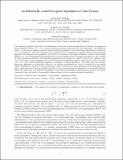| dc.contributor.author | Vempala, Santosh | |
| dc.contributor.author | Belloni, Alexandre | |
| dc.contributor.author | Freund, Robert Michael | |
| dc.date.accessioned | 2010-05-13T17:34:53Z | |
| dc.date.available | 2010-05-13T17:34:53Z | |
| dc.date.issued | 2009-08 | |
| dc.date.submitted | 2009-02 | |
| dc.identifier.issn | 1526-5471 | |
| dc.identifier.issn | 0364-765X | |
| dc.identifier.uri | http://hdl.handle.net/1721.1/54782 | |
| dc.description.abstract | The classical perceptron algorithm is an elementary row-action/relaxation algorithm for solving a homogeneous linear inequality system Ax > 0. A natural condition measure associated with this algorithm is the Euclidean width {tau} of the cone of feasible solutions, and the iteration complexity of the perceptron algorithm is bounded by 1/{tau}2 [see Rosenblatt, F. 1962. Principles of Neurodynamics. Spartan Books, Washington, DC]. Dunagan and Vempala [Dunagan, J., S. Vempala. 2007. A simple polynomial-time rescaling algorithm for solving linear programs. Math. Programming 114(1) 101–114] have developed a rescaled version of the perceptron algorithm with an improved complexity of O(n ln (1/{tau})) iterations (with high probability), which is theoretically efficient in {tau} and, in particular, is polynomial time in the bit-length model. We explore extensions of the concepts of these perceptron methods to the general homogeneous conic system Ax isin int K, where K is a regular convex cone. We provide a conic extension of the rescaled perceptron algorithm based on the notion of a deep-separation oracle of a cone, which essentially computes a certificate of strong separation. We show that the rescaled perceptron algorithm is theoretically efficient if an efficient deep-separation oracle is available for the feasible region. Furthermore, when K is the cross-product of basic cones that are either half-spaces or second-order cones, then a deep-separation oracle is available and, hence, the rescaled perceptron algorithm is theoretically efficient. When the basic cones of K include semidefinite cones, then a probabilistic deep-separation oracle for K can be constructed that also yields a theoretically efficient version of the rescaled perceptron algorithm. | en |
| dc.language.iso | en_US | |
| dc.publisher | Institute for Operations Research and the Management Sciences (INFORMS) | en |
| dc.relation.isversionof | http://dx.doi.org/10.1287/moor.1090.0388 | en |
| dc.rights | Attribution-Noncommercial-Share Alike 3.0 Unported | en |
| dc.rights.uri | http://creativecommons.org/licenses/by-nc-sa/3.0/ | en |
| dc.source | Robert Freund | en |
| dc.subject | Separation oracle | en |
| dc.subject | Conic system | en |
| dc.subject | Perception | en |
| dc.subject | Convex cones | en |
| dc.title | An Efficient Rescaled Perceptron Algorithm for Conic Systems | en |
| dc.type | Article | en |
| dc.identifier.citation | Belloni, Alexandre, Robert M Freund, and Santosh Vempala. “An Efficient Rescaled Perceptron Algorithm for Conic Systems.” MATHEMATICS OF OPERATIONS RESEARCH 34.3 (2009): 621-641. ©2009 INFORMS. | en |
| dc.contributor.department | Sloan School of Management | en_US |
| dc.contributor.approver | Freund, Robert Michael | |
| dc.contributor.mitauthor | Freund, Robert Michael | |
| dc.relation.journal | Mathematics of Operations Research | en |
| dc.eprint.version | Author's final manuscript | |
| dc.type.uri | http://purl.org/eprint/type/SubmittedJournalArticle | en |
| eprint.status | http://purl.org/eprint/status/PeerReviewed | en |
| dspace.orderedauthors | Belloni, A.; Freund, R. M.; Vempala, S. | en |
| dc.identifier.orcid | https://orcid.org/0000-0002-1733-5363 | |
| mit.license | OPEN_ACCESS_POLICY | en |
| mit.metadata.status | Complete | |
